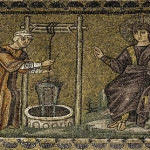We run our website the way we wished the whole internet worked: we provide high quality original content with no ads. We are funded solely by your direct support. Please consider supporting this project.

What the Cross Tells Us About God
Whether we’re talking about our relationship with God or with other people, the quality of the relationship can never go beyond the level of trust the relating parties have in each other’s character. We cannot be rightly related to God, therefore, except insofar as we embrace a trustworthy picture of him. To the extent that our mental picture of God is untrustworthy, we will not rely on him as our sole source of life.
Paul tells us that the gospel is “veiled … to those who are perishing” because “the god of this age has blinded” their minds so that they cannot see “the glory of Christ, who is the image of God” (2 Cor 3:14-15). Satan’s strategy is to attack our conception of God. The root of our alienation from God and our bondage to sin is our untrustworthy and unloving mental pictures of him. Those who are under Satan’s blinding oppression cannot receive the “light” that God wants to “shine in [their] hearts to give [them] the light of the knowledge of God’s glory displayed in the face of Christ” (2 Cor 4:3-6).
Only when the Spirit frees us from the blinding oppression of the “god of this age” can our hearts and minds see the glorious beauty of the God revealed in Christ. And only when we with “unveiled faces contemplate the Lord’s glory” can we be “transformed into his image with ever-increasing glory (2 Cor 3:17-18).
Jesus describes himself as “the way and the truth and the life” (John 14:6). The Greek word for “truth” (aletheia) means something like “uncovered” or “not concealed.” The glorious character of God is fully unveiled in Christ on the cross. As John wrote, no one had “ever seen God” or really known God up to that time. But the Son, “who is himself God … has made him known” (John 1:18).
When Jesus fully unveiled the true character of the one true God on the cross, he “disarmed the power and authorities,” vanquished Satan and his minions (Col 2:14-15), and thereby set free all who would accept the truth.
On the cross, the light expelled the darkness, the truth vanquished all deception, and the beauty of the true image of God destroyed the ugliness of all false images. And so now, for all who will yield to the Spirit, as the veil over our minds is removed, we can see “God’s glory displayed in the face of Jesus” (2 Cor 4:6) and be set free to enter into the loving, trusting, and transforming relationship God has always wanted to have with his people.
The cross is first and foremost the full disclosure of the true character of God and his pledge to demonstrate this loving, self-sacrificial character in all his dealings with us. We are challenged to take him at his word and to reciprocate by cultivating this same character in our relationship with him and all others. We do this not by striving, but by simply gazing on the beauty revealed in the cross with our minds and hearts open to the Spirit.
—adapted from Benefit of the Doubt, pages 235-237
Photo Credit: Jacob Meyer via Unsplash
Category: General
Tags: Benefit of the Doubt, Cross, Cruciform Theology, Jesus, Transformation
Related Reading

God is Different Than You Think
The revelation of “[a] God humiliated even unto the cross,” as Pascal put it, flies in the face of what most Jews of Jesus’ time, and of what most people throughout history, have expected God to be. In this light, we can discern the thematic centrality of the cross in Jesus’ many teachings that reverse…

Jesus Repudiates OT Commands on Oath-Taking: A Response to Paul Copan (#9)
In his critique of Crucifixion of the Warrior God (CWG), Paul Copan argues that “Boyd pushes too hard to make Jesus’ teaching appear more revolutionary than it really is” [italics original]. Whereas I argue that Jesus repudiates aspects of the Old Testament (OT), Copan argues that Jesus merely repudiates wrong applications of the OT, not…

The Cross as a Trinitarian Event
On Calvary, the all-holy God fully identified with sinners, suffering the consequences of our sin as though he himself were guilty. While God is never culpable for the evil he allows, he nevertheless assumes responsibility for it by fully identifying with those free agents who are in fact culpable. While the Son alone suffered as…

The Cruciform Center Part 3: How Paul’s Epistles Reveal a Cruciform God
As we’ve discussed, the four Gospels point to a cruciform revelation of God (click here and here for a review), but what about the most widely read writer of the New Testament? What did the Apostle Paul have to say about how the cross reveals who God is? Before turning to Paul’s writings, I’d like…

When God Abandoned God
On the cross, Jesus’ cried out, “Eli, Eli, lema sabachthani?” – which means, “My God, my God, why have you forsaken me? (Mt. 27:46). These are arguably the most shocking, beautiful, and profoundly revelatory words found in Scripture. The cry reveals that on Calvary, the all-holy Son of God experienced God-forsakenness as he bore the…

Smack Talk on the Idolatry of the Family
Ben Ponder doesn’t pull any punches in his article Idolatry of the Family. He argues that, contrary to some evangelical claims, “Jesus didn’t die on a God-forsaken cross to preserve your horn-rimmed vision of 1950s Americana.” Can a marriage or a family become an idol? Ben thinks so. What do you think? From the article:…
